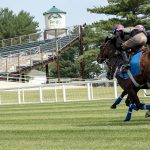Racehorse safety summit focuses on data
Returning to an in-person format for the first time since 2018, the 10th Welfare and Safety of the Racehorse Summit, held Wednesday in the Keeneland sales pavilion in Lexington, Kentucky, featured a range of presentations on the progress of the racing industry to promote the health of its equine and human athletes while focusing on the significance of data in facilitating these gains.
The summit was co-hosted by The Jockey Club and Grayson-Jockey Club Research Foundation and open to the public. It was emceed by Annise Montplaisir, equine education coordinator of the Kentucky Equine Education Project Foundation and president of Amplify Horse Racing.
A video replay of the summit, which was livestreamed, will be posted on the Grayson website next week.
- Colonial Downs: Latest jockey and trainer stats
 Which Colonial Downs jockeys and trainers are having a good meet? Who’s doing better than you’d think? Or heating up now? Answers within.
Which Colonial Downs jockeys and trainers are having a good meet? Who’s doing better than you’d think? Or heating up now? Answers within.
“The information shared at this year’s Welfare and Safety of the Racehorse Summit demonstrates how the Thoroughbred industry can come together to make meaningful positive changes,” said Jamie Haydon, president of Grayson. “It is clear that collecting and utilizing comprehensive data is key to maximizing the safety of our human and equine athletes. We are thankful to Keeneland for enabling us to host this event and to our speakers for sharing their wealth of knowledge for the benefit of our industry.”
Dr. Tim Parkin, head of Bristol Veterinary School, kicked off presentations with an update on the Equine Injury Database (EID). He reviewed findings from the database since it began collecting data in 2009, including a 31.5% drop in the rate of fatalities. He discussed the spike in 2-year-old fatalities in 2020, hypothesizing that this trend may have been caused by disruptions in training at the height of the COVID-19 pandemic.
Parkin also compared changes in risk for horses who compete on multiple surfaces versus those who race on one surface. Furthermore, he pointed out that sudden deaths have become a larger proportion of all fatalities since the advent of the EID as the decreasing rate of musculoskeletal injuries has outpaced the decline in sudden death rates.
Building off of the information in Parkin’s presentation, Dr. Larry Bramlage of Rood & Riddle Equine Hospital presented on the importance of training 2-year-olds. According to Bramlage, bones are dynamic organs that strengthen and remodel in response to exercise.
“Bone trains to the level of work, not the amount. The cardiovascular system trains to the amount of work,” Bramlage said. “The limiting system is always the skeleton in the horse.”
Given this knowledge and the aforementioned spike in 2-year-old fatalities in 2020, Bramlage believes that 2-year-olds racing that year may have been kept in a holding pattern in terms of intense training due to the uncertainty of race dates. Consequently, the development of their cardiovascular systems outpaced their skeletal systems.
Dr. Dionne Benson, chief veterinary officer of 1/ST Racing, talked about the changes implemented at 1/ST tracks following the highly publicized rash of breakdowns at Santa Anita Park in 2019. Among the protocols are an increased veterinary presence at the tracks, stricter medication rules during racing and training, additional monitoring on race day, out-of-competition testing, and required registration of a horse before participating in a timed workout. Santa Anita recently completed the safest Winter/Spring meet on record, showing a 74% improvement since the spring of 2019.
“We have changed to a culture of safety out there,” Benson said. “There is a conscious effort to put the horse first.”
Dr. Ryan Carpenter, who is a practicing surgeon at Equine Medical Center in California, described a program whereby racehorses that suffer complex musculoskeletal injuries on the track are given the opportunity to undergo surgery to repair their fractures if there is a favorable prognosis for them to ultimately become pasture-sound.
Joseph Appelbaum, president of the New York Thoroughbred Horsemen’s Association, moderated a panel on wearable technologies for horses. Valentin Rapin, managing director and co-founder of Arioneo, described his company’s sensors that horses can wear during training that track metrics such as heart rate.
Will Duff Gordon, the chief executive officer of Total Performance Data (TPD), talked about his company’s tracking technology and the potential benefits to gamblers. Equibase is currently working with TPD to harness this data and acknowledged the challenge of making this technology scalable.
“You’re looking for a technology that is attainable, that tradeoff, can every horse produce the same information to help with the welfare and the wagering, but not such that only a few racecourses can adopt it,” said Gordon.
“The last few years have been about acquiring the data, getting onto as many racecourses as possible, having a big enough data set. The present and the future is about mining that data.”
Dr. Scott Palmer, equine medical director of the New York State Gaming Commission, reviewed findings from a case study using StrideSAFE, a device that detects abnormalities in a horse’s gait and may have use in the future for detecting injuries before visible lameness develops. He sees great potential in the data from these technologies, especially with the imminent implementation of the Horseracing Integrity and Safety Act (HISA), which goes into effect July 1.
“I think that the introduction of HISA is going to make a huge change. They’re already requiring a lot of data, and it seems to me that right now the challenge is going to be to prioritize,” he said. “Having sensors on horses while they train and while they race is going to be important.”
In addition to serving as emcee, Montplaisir moderated a youth panel of individuals working in the Thoroughbred industry or pursuing a career in the industry. The group consisted of Hayley Amoss, manager, communications & social media, Breeders’ Cup; Hallie Hardy, executive director, Horse Country; Dr. Ferrin Peterson, jockey and veterinarian; Eric Resendiz, student at Bluegrass Community & Technical College and former Amplify Horse Racing mentee; and Deja Robinson, pre-vet student.
There was shared sentiment among the youth panel that participants in the Thoroughbred industry must take the time to educate those who are unfamiliar with the industry so that they develop a positive impression. They highlighted the impact of connecting with people on a personal level, either in person or through social media.
“People want a response that shows empathy,” said Amoss.
The summit included a regulatory panel that was moderated by Dr. Mary Scollay-Ward, executive director and chief operating officer of the Racing Medication & Testing Consortium. Formerly the equine medical director of the Kentucky Horse Racing Commission, she was joined by Dr. Will Farmer, equine medical director, Churchill Downs Inc.; Dr. Jaclyn Bradley, Prairie Meadows; and Dr. Lynn Hovda, chief commission veterinarian, Minnesota Racing Commission. The group offered their perspectives on the experience of a regulatory veterinarian, what they’ve learned, and challenges in the role. All agreed on the importance of clear communication with horsemen, owners, and other veterinarians across jurisdictions.
In a continuation on the work in California, Dr. Mathieu Spriet, professor of diagnostic imaging at University of California, Davis, presented findings from the use of positron emission tomography (PET) to evaluate fetlocks. In 2019, California installed a standing PET machine that can scan all four limbs in under 20 minutes without the use of anesthesia. The data demonstrated the efficacy of this technology for monitoring horses for injury and tracking healing.
Dr. Jerry Hill, chief medical adviser for the British Horseracing Authority (BHA), detailed a strategy by the BHA to improve the physical and mental wellbeing of jockeys by raising weights, prioritizing nutrition, and revamping areas at the racetracks that are dedicated to riders on race day.
Dr. Wayne McIlwraith, founding director of the Orthopaedic Research Center at Colorado State University, talked about the history of surface testing and the Racing Surfaces Testing Laboratory. Key factors in a safe racetrack are consistency, proper moisture content, and temperature. With HISA set to go into effect next month, racetracks will be required to have data protocols and standardized testing methods in place.
The summit concluded with presentations from Chris Dobbins, senior vice president of InCompass, and Dr. Stuart Brown, vice president of equine safety at Keeneland. Dobbins summarized the programs that InCompass offers to tracks to assist them in collecting and organizing data that is used to promote safety and welfare, including current efforts to facilitate record keeping once HISA goes into effect. Brown reviewed Keeneland’s safety protocols and how InCompass software provides Brown with important data for flagging horses that are at increased risk of injury.
The first Welfare and Safety of the Racehorse Summit was held in October 2006; subsequent summits were held in March 2008, June 2010, October 2012, July 2014, July 2015, June 2016, and June 2018. A virtual summit series was held in 2020.
Among the major accomplishments that have evolved from the previous nine summits are the Equine Injury Database; the Jockey Injury Database; the Racing Surfaces Testing Laboratory; a uniform trainer test and study guide; the racing surfaces white paper and publication of educational bulletins for track maintenance; the publication of stallion durability statistics; the Hoof: Inside and Out DVD, available in English and Spanish; protocols for horses working off of the veterinarian’s list; recommended regulations that void the claim of horses suffering injuries during a race; and inclement weather protocols.
LATEST NEWS
















